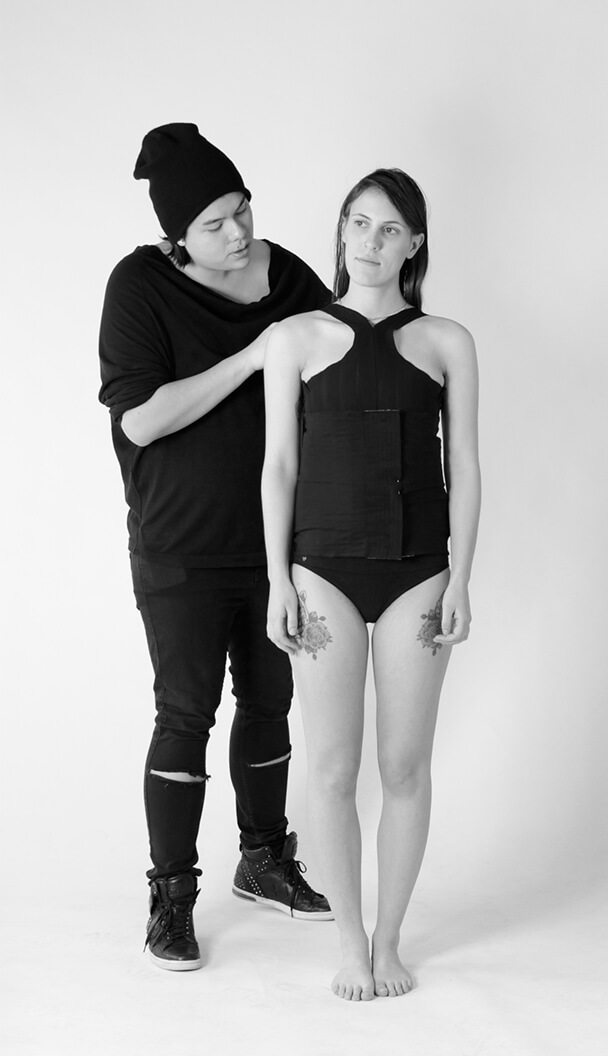All clothing is gendered, but for some it becomes a place of anxiety and social pressure. Whether masculine or feminine, there is often a strain to fit into certain expressions of genderidentities. Gender Performance Clothing is a project aiming to create garments that encourage active performativity and play, allowing for a more fluid experience of gender. This project is not about biology but rather about visible gender characteristics; essentially allowing for creation and navigation of comfort space within body image through role-play and dress up.
Gender Performance Clothing is comprised of two modular artifacts: a chest binder/bustier and waist-binder/girdle. These undergarments either enhance or diminish the user’s physical geometry. Physical gender traits—archetypal silhouettes; wide masculine shoulders, or wide feminine hips—altered by these garments into new physical geometries, allow users to adjust their appearance to a desired point in a spectrum of genders. Those who are genderqueer, misgendered, as well as those uncomfortable with their body image can take active control of their body representation. However, these garments are not just for those who don’t fit into a gender binary but also for those who adhere to it as well. Cisgendered users (users who identify with their given biology), queer, and alternative users alike—people—navigate body image in their own way, dealing with issues of insecurity, self expression, and finding their own voice. With Gender Performance Clothing each user has the ability to find a sense of security, to express themselves, and to open gender and body image up to critical dialogue.
Each user has the ability to find a sense of security, to express themselves, and to open gender and body image up to critical dialogue.
Navigating issues of gender and body image will always be difficult. Part of the process for this project included negotiating whether to address a clothed silhouette or being more invasive by augmenting the body with performance-wear-like undergarments. Undergarments embody an active performativity, whereas clothes are more passive. We don’t often think about the history or subtle gendering of clothing: “Historically men’s dress shirts button on the right, whereas generally a women’s dress shirt will button on the left.” Conversely, undergarments engage in active performance; augmenting our performance, body language, as well as our expression of gender and sexuality,
all of which can be explained through underwear: “Do you own ‘boring’ underwear, and in contrast, how do you act when wearing ‘sexy’ or even exotic underwear?” That is to say, that these garments engage in something akin to body augmentation; changing the way we act and think about our bodies.
This project started with creating garments that perform gender using traditional methods of body modification; padding, binding, bras, and corsets. Using these same methods of modification, each of their mechanisms was amalgamated to create the current textile treatment, which allows Gender Performance Clothing to contour and enhance the body. The textile uses Nylon Mesh, a highly elastic stretch fabric, allowing the garment to fit flush to the body while still enabling air flow; an interfacing layer controls the expansion of the textile and prevents any warping, and strips of elastic grip tape gently pulls the body to create or negate cleavage.
![]()
Due to the modular nature of these undergarments, there is motion in wearing. Thismeans that the mode or use of the garment changes with each way that it is worn. When the top is worn with the closure on the front, it becomes a bustier creating cleavage, with or without the presence of breasts. Likewise, when worn with the closure on the back, it becomes a binder, flattening the chest and straightening the back. Using padding, it creates an hourglass figure when the bottom garment is worn on the hips. Conversely, it gives a straighter figure when worn on the waist.
As next steps, I would like to address issues of size and fit, as well as how the undergarments interact with clothes. In addressing these issues, enabling agency continues to be the guiding principle in this project; granting the user control over their bodily representation, allowing for personal voice, and even opening up gender and the body to critical conversation. Offering modularity in the garment constructions and enabling users to develop their own aesthetic through these garments are important aspects that lead to empowerment. This allows people who might otherwise feel abject or pressured to fit into certain expressions of gender to feel in control of their body, encouraging active performativity and play for a more fluid experience of gender.
Willam Alexander is an industrial designer exploring gender and their diversifications by triggering new design ideas.

